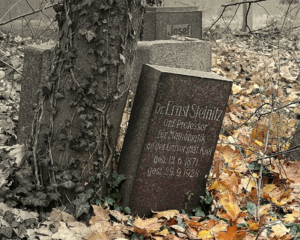Ernst Steinitz facts for kids
Quick facts for kids
Ernst Steinitz
|
|
|---|---|

Tombstone of Ernst Steinitz, Old Jewish Cemetery, Wrocław (street Lotnicza).
|
|
| Born | 13 June 1871 Laurahütte, Silesia, Germany
|
| Died | 29 September 1928 (aged 57) |
| Nationality | German |
| Alma mater | University of Breslau |
| Scientific career | |
| Fields | Mathematics |
| Institutions | University of Kiel |
| Doctoral advisor | Jakob Rosanes |
Ernst Steinitz (born June 13, 1871 – died September 29, 1928) was an important German mathematician. He is best known for his work on field theory and polyhedra. His ideas helped shape how we understand modern algebra.
Contents
A Life in Mathematics
Ernst Steinitz was born in a place called Laurahütte, which was in Germany at the time. Today, this area is part of Poland. His father was a coal merchant, and Ernst had two brothers.
He loved to learn and studied at the University of Breslau and the University of Berlin. He earned his Ph.D. from the University of Breslau in 1894.
After finishing his studies, Steinitz worked at several universities. He taught at Charlottenburg (now the Technical University of Berlin), Breslau, and the University of Kiel in Germany. He passed away in Kiel in 1928. Steinitz was married to Martha Steinitz and they had one son.
Steinitz's Big Ideas in Math
Steinitz made several important contributions to mathematics. His work helped create new ways of thinking about numbers and shapes.
Understanding Configurations
In 1894, Steinitz wrote his Ph.D. paper about something called "projective configurations." Imagine you have a set of points and lines. A configuration describes how these points and lines connect to each other.
Steinitz showed that certain patterns of points and lines could always be drawn using straight lines. His work also included a proof of Kőnig's theorem. This theorem is about special kinds of graphs, which are like networks of points and lines.
The Theory of Fields
One of Steinitz's most famous works was a paper published in 1910. It was called Algebraische Theorie der Körper, which means "Algebraic Theory of Fields" in German. This paper was very influential.
- In this paper, he looked at "fields" in mathematics. A field is a set of numbers (or other mathematical objects) where you can add, subtract, multiply, and divide, just like with regular numbers.
- He defined important ideas like prime field and perfect field.
- He also showed that every field has something called an algebraic closure. Think of it as adding all possible "roots" to a field so that every equation has a solution within that field.
- Many mathematicians consider this paper a foundational work for modern algebra.
Polyhedra and Their Skeletons
Steinitz also made key discoveries about polyhedra. A polyhedron is a 3D shape with flat faces, straight edges, and sharp corners, like a cube or a pyramid.
- Steinitz's theorem for polyhedra is a famous result. It connects 3D shapes to 2D drawings.
- It says that if you take the "skeleton" of a convex polyhedron (just its edges and corners), you can always draw it as a special kind of graph on a flat surface.
- This graph will be "3-connected" (meaning you need to remove at least three corners to break it apart) and "planar" (meaning it can be drawn without any lines crossing).
- His work on polyhedra was published after he passed away, in a book by Hans Rademacher.
See also
 In Spanish: Ernst Steinitz para niños
In Spanish: Ernst Steinitz para niños
- Hall algebra
- Hauptvermutung
- Medial graph
- Steinitz class
- Steinitz exchange lemma
- Supernatural numbers
- Lévy–Steinitz theorem

